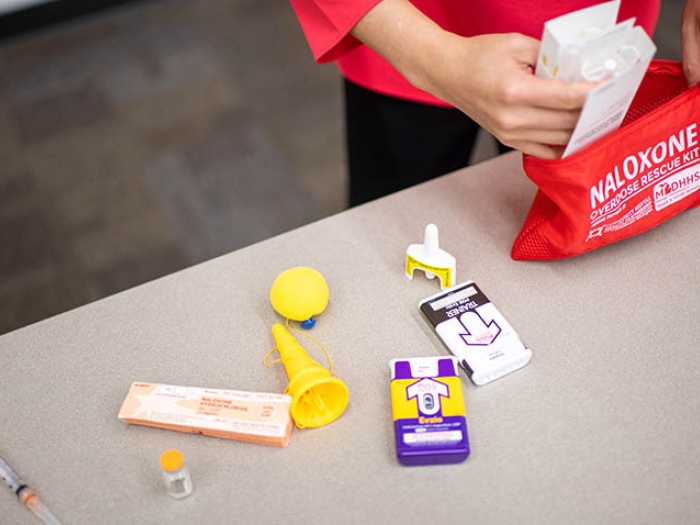“Secret shopper” study reveals 40 percent of primary care clinics will not accept a new patient who takes opioids on an ongoing basis, reducing their access to needed care
8:27 AM
Author |

Finding a new doctor for health checkups and primary care can pose a challenge to anyone. But for people who take prescription opioid pills for their chronic pain, it might be much harder, according to a new study.
In fact, 40 percent of 194 primary care clinics contacted for the study said they would not accept a new patient who takes Percocet daily for pain from a past injury, no matter what kind of health insurance they had.
LISTEN UP: Add the new Michigan Medicine News Break to your Alexa-enabled device, or subscribe to our daily updates on iTunes, Google Play and Stitcher.
Another 17 percent of the clinics said they would want more information before deciding whether to take on the patient; two-thirds of these said they would want the patient to come for a preliminary appointment before making a decision. All of the clinics involved in the study were accepting new patients at the time.
The findings, published in JAMA Network Open by a team from the University of Michigan, suggest that more patients who take opioids for chronic pain could face health care access problems, which previous studies have suggested.
However, the team did find that larger clinics and those that offer safety net coverage were three times more likely than others to accept patients who currently take opioids for chronic pain.
More than just pain management
For such patients, getting access to primary care goes beyond checkups, preventive care and management of medical conditions, says lead researcher Pooja Lagisetty, M.D., M.Sc.
Having a regular provider could enable them to receive other pain-relieving treatments, and if indicated, provide guidance in safely and gradually tapering their use of opioids.
Primary care providers can also equip patients who take opioids, or their loved ones, with a "rescue" drug to use in case of an opioid overdose, screen patients for signs of opioid use disorders, and treat such disorders if the patient is among the minority of people on long-term prescription opioid treatment who develop an addiction to the drugs.
Without access to such care, the researchers note, patients may turn to other means of obtaining opioids, outside of a prescription from a regular provider. It also may lead to worsened health outcomes for their other medical issues like diabetes or high blood pressure.
In fact, Lagisetty says, that's what led her and her colleagues to launch the study with funding from the Michigan Health Endowment Fund. Lagisetty is a general internal medicine physician at Michigan Medicine, U-M's academic medical center, and the VA Ann Arbor Healthcare System.
"Anecdotally, we were hearing about patients with chronic pain becoming 'pain refugees', being abruptly tapered from their opioids or having their current physician stop refilling their prescription, leaving them to search for pain relief elsewhere," she says. "However, there have been no studies to quantify the extent of the problem. These findings are concerning because it demonstrates just how difficult it may be for a patient with chronic pain searching for a primary care physician."
Calling around for care
The team did the study using a "secret shopper" method, to get a realistic sense of what clinics would tell someone who called to inquire about whether their parent could get an appointment as a new patient. The first round of calls went to 667 randomly chosen Michigan clinics, to ask if they were accepting new primary care patients and other questions.
For the second round of calls, the researchers used the scenario of an adult child calling on behalf of a parent, so that the conversations did not need to include detailed information about the patient for the purposes of scheduling an appointment.
Everyone deserves equitable access to health care, irrespective of their medical conditions or what medications they may be taking.Pooja Lagisetty, M.D., M.Sc.
The callers also said that their "parent" was taking medications for high blood pressure and high cholesterol, two conditions that primary care providers play key roles in managing.
The researchers wanted to find out if type of insurance, size or type of clinic, or population density around the clinic, played any role. Half of the callers said their parent had Medicaid, the other half said they had Blue Cross Blue Shield coverage. Nearly half the clinics were in rural areas, and nearly one-third had a single provider. Nine percent were community health centers, which provide care to anyone regardless of ability to pay.
"Our results did not differ by insurance status, which was surprising because previous studies on primary care access have showed that patients on Medicaid tend to have lower access to primary care than those with private insurance," says Lagisetty. "This may indicate that providers and clinics are not making these decisions to restrict access based upon reimbursement. Larger clinics and community health centers were more likely to accept new patients suggesting that there may be some system level factors that affect access to care."
There was no difference in access between rural and urban areas.
Getting help for addiction issues
The researchers also looked at the availability of treatment for opioid use disorder at the primary care clinics.
MORE FROM MICHIGAN: Sign up for our weekly newsletter
Such treatment, which requires providers to get special training and permission from the federal government, involves counseling and prescriptions for medications that can block the symptoms of withdrawing from opioids. Lagisetty has looked at the feasibility of primary care clinics offering such treatment, and differences in access to it.
The front-line staff at 12 percent of the clinics in the study said their providers offered this kind of medication-based opioid use disorder (OUD) care. Nearly 41 percent told callers they didn't know if their providers were able to offer it.
Next steps
What factors play a role in a clinic's decision to take on new patients with chronic pain who take prescription opioids? Lagisetty notes that patient advocates have placed blame on a 2016 chronic pain treatment guide from the Centers for Disease Control and Prevention, which they see as swinging the pain-treatment pendulum too far away from prescription opioids.
"I suspect this is only a small part of the problem," says Lagisetty, who is a member of the U-M Institute for Healthcare Policy and Innovation. "States, including Michigan, have implemented many other policies that are only occasionally based on the guidelines, in an effort to restrict opioid prescribing."
The Michigan team wants to study the factors responsible for this phenomenon further, and determine how much is related to recent guidelines and policies, how much is stigma against patients on opioid therapy, and how much is provider fear of legal repercussions.
"We hope to use this information to identify a way for us to fix the policies to have more of a patient-centered approach to pain management," says Lagisetty. "Everyone deserves equitable access to health care, irrespective of their medical conditions or what medications they may be taking."
In addition to Lagisetty, the study's authors are Nathaniel Healy, B.S.; Claire Garpestad, B.S.; Mary Jannausch, M.S. and IHPI members Renuka Tipirneni, M.D., M.Sc. of General Medicine; and Amy S. B. Bohnert, PhD, MHS of the Department of Psychiatry.
Paper Cited: JAMA Network Open, DOI:10.1001/jamanetworkopen.2019.6928

Explore a variety of healthcare news & stories by visiting the Health Lab home page for more articles.

Department of Communication at Michigan Medicine
Want top health & research news weekly? Sign up for Health Lab’s newsletters today!





